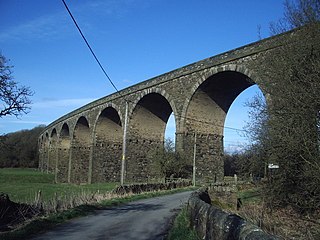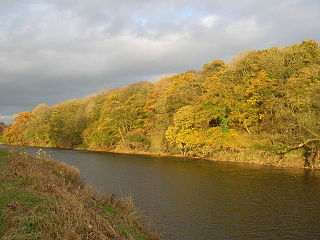
Martholme Viaduct is a 19th-century railway viaduct in the English county of Lancashire. It lies between the town of Great Harwood and the village of Read, and lies in both the district of Hyndburn and that of Ribble Valley. The viaduct was constructed 1870–77 by engineer Sturges Meek. It was built to carry the Great Harwood Loop of the East Lancashire Line over the River Calder. That part of the line closed in 1957.
Burrow-with-Burrow is a civil parish in Lancaster, Lancashire, England. It contains 25 listed buildings that are recorded in the National Heritage List for England. Of these, one is listed at Grade I, the highest of the three grades, one is at Grade II*, the middle grade, and the others are at Grade II, the lowest grade. It contains a number of small settlements, including Nether Burrow, Over Burrow, Overtown and Cowan Bridge, and is otherwise rural. The major building in the parish is Burrow Hall; this country house and structures associated with it are listed. Most of the older listed buildings are domestic or agricultural, including houses and associated structures, farmhouses, and farm buildings. Later listed structures are four milestones and four boundary stones. The other listed buildings are a bridge, and inscribed stones re-set into a different bridge.
Gressingham is a civil parish in Lancaster, Lancashire, England. It contains 14 listed buildings that are recorded in the National Heritage List for England. Of these, one is listed at Grade I, the highest of the three grades, two are at Grade II*, the middle grade, and the others are at Grade II, the lowest grade. Apart from the village of Gressingham and the settlement of Eskrigge, the parish is rural. Almost all the listed buildings are houses and associated structures, farmhouses, and farm buildings. Also listed are a church and a bridge crossing the River Lune on the boundary of the parish.
Barton is a civil parish in the City of Preston, Lancashire, England. It contains ten listed buildings that are recorded in the National Heritage List for England. Of these, one is at Grade II*, the middle grade, and the others are at Grade II, the lowest grade. The parish contains the village of Barton and surrounding countryside. Running through it is the Lancaster Canal, and a bridge crossing it and an aqueduct are listed. The other listed buildings include farm buildings, milestones, a church, and a cross.
Billington and Langho is a civil parish in Ribble Valley, Lancashire, England. It contains nine listed buildings that are recorded in the National Heritage List for England. Of these, two are listed at Grade I, the highest of the three grades, one is at Grade II*, the middle grade, and the others are at Grade II, the lowest grade. The parish contains the villages of Billington and Langho, and is otherwise mainly rural. The listed buildings are houses, farmhouses, a farm building, and a church.
Chatburn is a civil parish in Ribble Valley, Lancashire, England. It contains six listed buildings that are recorded in the National Heritage List for England. Of these, one is at Grade II*, the middle grade, and the others are at Grade II, the lowest grade. The parish contains the village of Chatburn and surrounding countryside. The listed buildings consist of houses, farmhouses, and a church.
Clayton-le-Dale is a civil parish in Ribble Valley, Lancashire, England. It contains five listed buildings that are recorded in the National Heritage List for England. Of these, one is at Grade II*, the middle grade, and the others are at Grade II, the lowest grade. The parish contains the village of Clayton-le-Dale and surrounding countryside. The listed buildings consist of houses, a former toll house, and a bridge.
Downham is a civil parish in Ribble Valley, Lancashire, England. It contains 43 listed buildings that are recorded in the National Heritage List for England. Of these, three are at Grade II*, the middle grade, and the others are at Grade II, the lowest grade. The parish contains the village of Downham and surrounding countryside. Most of the listed buildings are in the village, and include Downham Hall and associated structures, houses and cottages, a church, a public house, a school, milestones, a bridge, and a set of stocks. Outside the village the listed buildings are farmhouses and farm buildings.
Great Mitton is a civil parish in Ribble Valley, Lancashire, England. It contains 17 listed buildings that are recorded in the National Heritage List for England. Of these, one is listed at Grade I, the highest of the three grades, one is at Grade II*, the middle grade, and the others are at Grade II, the lowest grade. The parish contains the village of Great Mitton and is otherwise completely rural. It is bounded by the Rivers Hodder and Ribble, and bridges crossing them are listed. The other listed buildings include houses, farmhouses, a barn, a church with associated strictures, public houses, a cross base, and a milestone.
Longridge is a civil parish in Ribble Valley, Lancashire, England. It contains 15 listed buildings that are recorded in the National Heritage List for England. Of these, one is at Grade II*, the middle grade, and the others are at Grade II, the lowest grade. The parish contains the town of Longridge and surrounding countryside. Most of the listed buildings are houses and farmhouses. The others include three churches, an inscribed stone, a tunnel portal, and a war memorial.
Mellor is a civil parish in Ribble Valley, Lancashire, England. It contains ten listed buildings that are recorded in the National Heritage List for England. Of these, one is at Grade II*, the middle grade, and the others are at Grade II, the lowest grade. The parish contains the village of Mellor, and is otherwise rural. The only listed building in the village is the church. The other listed buildings are houses and associated structures, farmhouses, and a bridge.
Osbaldeston is a civil parish in Ribble Valley, Lancashire, England. It contains five listed buildings that are recorded in the National Heritage List for England. Of these, three are at Grade II*, the middle grade, and the other two are at Grade II, the lowest grade. The parish contains the village of Osbaldeston, and is otherwise rural. The listed buildings consist of two country houses, a barn, a church with attached presbytery, and a school.
Pendleton is a civil parish in Ribble Valley, Lancashire, England. It contains 18 listed buildings that are recorded in the National Heritage List for England. Of these, one is at Grade II*, the middle grade, and the others are at Grade II, the lowest grade. The parish contains the village of Pendleton, and is otherwise rural. All the listed buildings are houses and associated structures, or farmhouses and farm buildings, either in the village, or in the surrounding area.
Read is a civil parish in Ribble Valley, Lancashire, England. It contains seven listed buildings that are recorded in the National Heritage List for England. Of these, one is at Grade II*, the middle grade, and the others are at Grade II, the lowest grade. The most important building in the parish is the country house Read Hall; this and a number of structures in the grounds are listed. The other listed buildings are a church, a farmhouse, and a railway viaduct.
Ribchester is a civil parish in Ribble Valley, Lancashire, England. It contains 23 listed buildings that are recorded in the National Heritage List for England. Of these, one is listed at Grade I, the highest of the three grades, one is at Grade II*, the middle grade, and the others are at Grade II, the lowest grade. The parish contains the village of Ribchester, and surrounding countryside. Most of the listed buildings are houses and associated structures, or farmhouses and farm buildings, some of which are in the village, and others are in the rural area. The other listed buildings are two churches, a presbytery, a sundial, a public house with a mounting block outside, a bridge, and almshouses with a wellhead in the grounds.
Sabden is a civil parish in Ribble Valley, Lancashire, England. It contains four listed buildings that are recorded in the National Heritage List for England. All of the listed buildings are designated at Grade II, the lowest of the three grades, which is applied to "buildings of national importance and special interest". The parish contains the village of Sabden and surrounding countryside. The listed buildings consist of two houses, a farmhouse, and a church.
Salesbury is a civil parish in Ribble Valley, Lancashire, England. It contains four listed buildings that are recorded in the National Heritage List for England. All of the listed buildings are designated at Grade II, the lowest of the three grades, which is applied to "buildings of national importance and special interest". The parish contains the village of Salesbury and the residential area of Copster Green, and is otherwise rural. The listed buildings consist of a farmhouse with an attached stable, and two houses, one with a sundial base in the grounds.
Wiswell is a civil parish in Ribble Valley, Lancashire, England. It contains seven listed buildings that are recorded in the National Heritage List for England. Of these, one is listed at Grade I, the highest of the three grades, and the others are at Grade II, the lowest grade. The parish contains the small village of Wiswell, and is otherwise rural. The listed buildings consist of houses, farmhouses, a barn, and a medieval wayside cross.
Penwortham is a civil parish in the South Ribble district of Lancashire, England. It contains 12 buildings that are recorded in the National Heritage List for England as designated listed buildings. Of these, one is listed at Grade II*, the middle grade, and the others are at Grade II, the lowest grade. The parish contains the town of Penwortham and surrounding countryside. The listed buildings include a medieval wayside cross, a church and structures in the churchyard, houses of varying dates, an inn, and a railway viaduct carrying the West Coast Main Line over the River Ribble.
Samlesbury is a civil parish in the South Ribble district of Lancashire, England. It contains 22 listed buildings that are recorded in the National Heritage List for England. Of these, two are listed at Grade I, the highest of the three grades, and the others are at Grade II, the lowest grade. The parish is mainly rural, and many of its listed buildings are houses, farmhouses and farm buildings. The most important buildings are Samlesbury Hall and the parish church, both of which are listed at Grade I. The other listed buildings include structures associated with the church, a school, a bridge, a church built in the 19th century, and a lodge to the hall.








